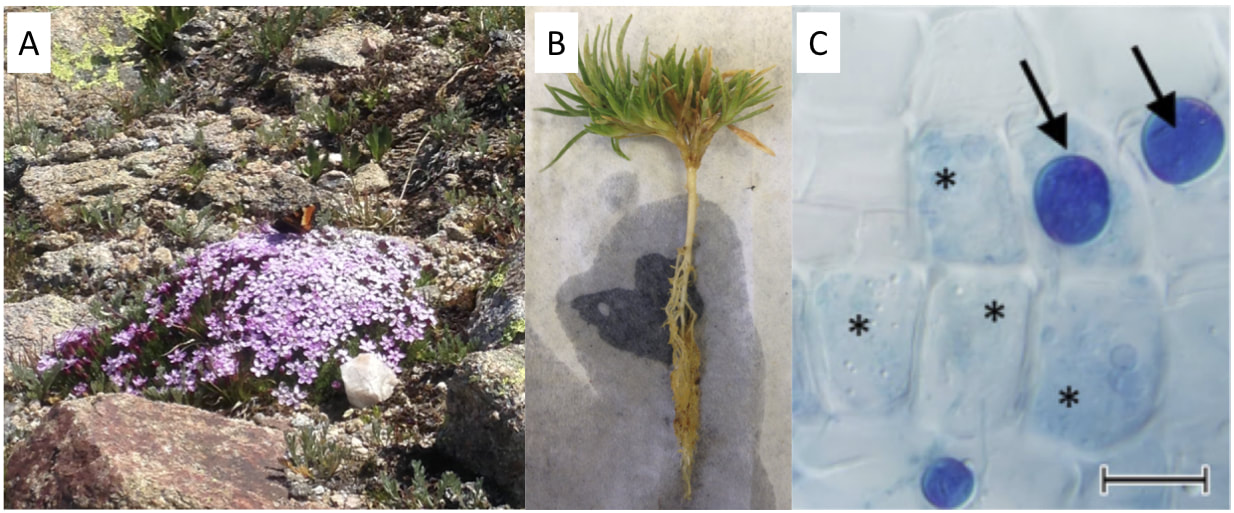|
by Cliff Bueno de Mesquita Serendipita is a genus of mycorrhizal fungi from a different lineage than most other mycorrhizae. Remember, a mycorrhizal fungus is one that forms a mutualism with a plant, helping the plant uptake nutrients in exchange for carbon that the plant creates through photosynthesis. Serendipita are in the order Sebacinales, class Agaricomycetes, phylum Basidiomycota. Fungi in the order Sebacinales were originally considered “orchid mycorrhizae”, as they were thought to only associate with orchid plants. However, they have now been found in mosses, ferns, and a variety of other plants including wheat, maize, poplar, and tomato. In our own work, we found that Serendipita was a dominant fungus found inside the roots of the moss campion Silene acaulis, a beautiful arctic-alpine plant with a circumpolar distribution (Figure 1A, 1B). We sequenced the fungal DNA found inside the roots of Silene acaulis from plants at our site in Colorado, as well as from plants from Ireland, in collaboration with a visiting Fulbright scholar Conor Meade, from the University of Maynooth, Ireland. We defined “dominant” as a fungus being in the top 10% most abundant fungi in the roots, and found in over 50% of the individual plants sampled (Delgado-Baquerizo et al. 2018). Serendipita was one of only four known fungal genera that qualified as dominant, so we think it is playing a role in the growth of Silene acaulis. The genus Serendipita was first described in 1993 (Roberts 1993). One of the species in the genus, Serendipita vermifera, has been shown to increase the growth of switchgrass, which is grown as a bioenergy crop (Ray et al. 2018). Another species, Serendipita indica, was shown to increase the growth of the plant used to make turmeric (Bhola et al. 2017). Researchers are currently working on growing this fungus in large quantities to then add to soil to promote plant growth (Singhal et al. 2017). References: Bhola, D., Bajaj, R., Tripathi, S., Varma, A. 2017. Piriformospora indica(Serendipita indica) enhances growth and secondary metabolites in Cucurma longa. In: Varma, A., Prasad, R., Tuteja, N., (eds). Mycorrhiza – Nutrient Uptake, Biocontrol, Ecorestoration. Springer, Cham. Delgado-Baquerizo, M., Oliverio, A.M., Brewer, T.E., Benavent-González, A., Eldridge, D.J., Bardgett, R.D., Maestre, F.T., Singh, B.K., Fierer, N. 2018. A global atlas of the dominant bacteria found in soil. Science359: 320-325. Ray, P., Guo, Y., Sun, L., Tang, Y., Craven, K.D., Gilna, P. 2018. Signaling between switchgrass and fungal endosymbionts in the genus Serendipita. https://genomicscience.energy.gov/pubs/2017abstracts/abstractpdfs/73_Gilna_Paul_Ray.pdf Roberts P. 1993. Exidiopsis species from Devon, including the new segregate genera Ceratosebacina, Endoperplexa, Microsebacina, and Serendipita. Mycological Research. 97 (4): 467–78. doi:10.1016/S0953-7562(09)80135-4. Singhal, U., Attri, M.K., Varma, A. 2017. Mass cultivation of mycorrhiza-like fungus Piriformospora indica(Serendipita indica) by batch in bioreactor. In: Varma, A., Prasad, R., Tuteja, N. (eds). Mycorrhiza – Function, Diversity, State of the Art. Springer, Cham. Vohník, M., Pánek, M., Fehrer, J., Selosse, M. 2016. Experimental evidence of ericoid mycorrhizal potential within Serendipitaceae (Sebacinales). Mycorrhiza26(8): 831-846.
0 Comments
Leave a Reply. |
AuthorVarious lab members contribute to the MoM Blog Archives
October 2023
Categories |


 RSS Feed
RSS Feed
